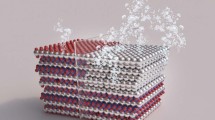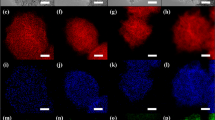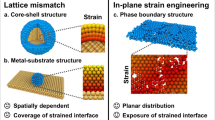Abstract
Efficient evolution of hydrogen through electrocatalysis at low overpotentials holds tremendous promise for clean energy. Hydrogen evolution can be easily achieved by electrolysis at large potentials that can be lowered with expensive platinum-based catalysts. Replacement of Pt with inexpensive, earth-abundant electrocatalysts would be significantly beneficial for clean and efficient hydrogen evolution. To this end, promising results have been reported using 2H (trigonal prismatic) XS2 (where X = Mo or W) nanoparticles with a high concentration of metallic edges. The key challenges for XS2 are increasing the number and catalytic activity of active sites. Here we report monolayered nanosheets of chemically exfoliated WS2 as efficient catalysts for hydrogen evolution with very low overpotentials. Analyses indicate that the enhanced electrocatalytic activity of WS2 is associated with the high concentration of the strained metallic 1T (octahedral) phase in the as-exfoliated nanosheets. Our results suggest that chemically exfoliated WS2 nanosheets are interesting catalysts for hydrogen evolution.
This is a preview of subscription content, access via your institution
Access options
Subscribe to this journal
Receive 12 print issues and online access
$259.00 per year
only $21.58 per issue
Buy this article
- Purchase on Springer Link
- Instant access to full article PDF
Prices may be subject to local taxes which are calculated during checkout



Similar content being viewed by others
References
Greeley, J. et al. Computational high-throughput screening of electrocatalytic materials for hydrogen evolution. Nature Mater. 5, 909–913 (2006).
Laursen, L. B., Kegnæs, S., Dahla, S. & Chorkendorff, I. Molybdenum sulfides efficient and viable materials for electro- and photoelectrocatalytic hydrogen evolution. Energy Environ. Sci. 5, 5577–5591 (2012).
Hinnemann, B. et al. Biomimetic hydrogen evolution: MoS2 nanoparticles as catalyst for hydrogen evolution. J. Am. Chem. Soc. 127, 5308–5309 (2005).
Jaramillo, T. F. et al. Identification of active edge sites for electrochemical H2 evolution from MoS2 nanocatalysts. Science 317, 100–102 (2007).
Jaramillo, T. F. et al. Hydrogen evolution on supported incomplete cubane-type [Mo3S4]4+ electrocatalysts. J. Phys. Chem. C 112, 17492–17498 (2008).
Bonde, J. et al. Hydrogen evolution on nano-particulate transition metal sulfides. Faraday Discuss. 140, 219–231 (2008).
Nørskov, J. K., Bligaard, T., Rossmeisl, J. & Christensen, C. H. Towards the computational design of solid catalysts. Nature Chem. 1, 37–46 (2009).
Subbaraman, R. et al. Enhancing hydrogen evolution activity in water splitting by tailoring Li+-Ni (OH)2–Pt interfaces. Science 334, 1256–1260 (2011).
Hou, Y. et al. Bioinspired molecular co-catalysts bonded to a silicon photocathode for solar hydrogen evolution. Nature Mater. 10, 434–438 (2011).
Seger, B. et al. Hydrogen production using a molybdenum sulfide catalyst on a titanium-protected n+p-silicon photocathode. Angew. Chem. Int. Ed. 51, 9128–9131 (2012).
Bollinger, M. V. et al. One-dimensional metallic edge states in MoS2 . Phys. Rev. Lett. 87, 196803 (2001).
Le Goff, A. et al. From hydrogenases to noble metal-free catalytic nanomaterials for H2 production and uptake. Science 326, 1384–1387 (2009).
Karunadasa, H. I., Chang, C. J. & Long, J. R. A molecular molybdenum-oxo catalyst for generating hydrogen from water. Nature 464, 1329–1333 (2010).
Helm, M. L., Stewart, M. P., Bullock, R. M., Rakowski DuBois, M. & DuBois, D. L. A synthetic nickel electrocatalyst with a turnover frequency above 100,000 s−1 for H2 production. Science 333, 863–866 (2011).
Karunadasa, H. I. et al. A molecular MoS2 edge site mimic for catalytic hydrogen generation. Science 335, 698–702 (2012).
Merki, D., Fierro, S., Vrubel, H. & Hu, X. Amorphous molybdenum sulfide films as catalysts for electrochemical hydrogen production in water. Chem. Sci. 2, 1262–1267 (2011).
Vrubel, H., Merki, D. & Hu, X. Hydrogen evolution catalyzed by MoS3 and MoS2 particles. Energy Environ. Sci. 5, 6136–6144 (2012).
Chen, Z. et al. Core shell MoO3–MoS2 nanowires for hydrogen evolution: A functional design for electrocatalytic materials. Nano Lett. 11, 4168–4175 (2011).
Kibsgaard, J., Chen, Z., Reinecke, B. N. & Jaramillo, T. F. Engineering the surface structure of MoS2 to preferentially expose active edge sites for electrocatalysis. Nature Mater. 11, 963–969 (2012).
Li, Y. et al. MoS2 nanoparticles grown on graphene: An advanced catalyst for the hydrogen evolution reaction. J. Am. Chem. Soc. 133, 7296–7299 (2011).
Joensen, P., Frindt, R. F. & Morrison, S. R. Single-layer MoS2 . Mater. Res. Bull. 21, 457–461 (1986).
Novoselov, K. S. et al. Two-dimensional atomic crystals. Proc. Natl Acad. Sci. USA 102, 10451–10453 (2005).
Splendiani, A. et al. Emerging photoluminescence in monolayer MoS2 . Nano Lett. 10, 1271–1275 (2010).
Coleman, J. N. et al. Two-dimensional nanosheets produced by liquid exfoliation of layered materials. Science 331, 568–571 (2011).
Zhan, Y. et al. Large-area vapor-phase growth and characterization of MoS2 atomic layers on a SiO2 substrate. Small 8, 966–971 (2012).
Liu, K. K. et al. Growth of large-area and highly crystalline MoS2 thin layers on insulating substrates. Nano Lett. 12, 1538–1544 (2012).
Lee, Y-H. et al. Synthesis of large-area MoS2 atomic layers with chemical vapor deposition. Adv. Mater. 24, 2320–2325 (2012).
Chang, Y-H. et al. Highly efficient electrocatalytic hydrogen production by MoSx grown on graphene-protected 3D Ni foams. Adv. Mater. 5, 756–760 (2012).
Radisavljevic, B., Radenovic, A., Brivio, J., Giacometti, V. & Kis, A. Single-layer MoS2 transistors. Nature Nanotech. 6, 147–150 (2011).
Li, T. & Galli, G. Electronic properties of MoS2 nanoparticles. J. Phys. Chem. C 111, 16192–16196 (2007).
Mak, K. F., Lee, C., Hone, J., Shan, J. & Heinz, T. F. Atomically thin MoS2: A new direct-gap semiconductor. Phys. Rev. Lett. 105, 136805 (2010).
Eda, G. et al. Photoluminescence from chemically exfoliated MoS2 . Nano Lett. 11, 5111–5116 (2011).
Py, M. A. & Haering, R. R. Structural destabilization induced by lithium intercalation in MoS2 and related compounds. Can. J. Phys. 61, 76–84 (1983).
Tsai, H-L., Heising, J., Schindler, J. L., Kannewurf, C. R. & Kanatzidis, M. G. Exfoliated-restacked phase of WS2 . Chem. Mater. 9, 879–882 (1997).
Paracchino, A., Laporte, V., Sivula, K., Grätzel, M. & Thimse, E. Highly active oxide photocathode for photoelectrochemical water reduction. Nature Mater. 10, 456–461 (2011).
Miremadi, B. K. & Morrison, S. R. The intercalation and exfoliation of tungsten disulfide. J. Appl. Phys. 63, 4970–4974 (1988).
Heising, J. & Kanatzidis, M. G. Structure of restacked MoS2 and WS2 elucidated by electron crystallography. J. Am. Chem. Soc. 121, 638–643 (1999).
Galindo, P. L. et al. The peak pairs algorithm for strain mapping from HRTEM images. Ultramicroscopy. 107, 1186–1193 (2007).
Yang, D. & Frindt, R. F. Li-intercalation and exfoliation of WS2 . J. Phys Chem Solids. 57, 1113–1116 (1996).
Green, C. L. & Kucernak, A. Determination of the platinum and ruthenium surface areas in platinum–ruthenium alloy electrocatalysts by underpotential deposition of copper. I. Unsupported catalysts. J. Phys. Chem. B 106, 1036–1047 (2002).
Kilgore, U. J. et al. [Ni(PPh2NC6H4X2)2]2+ complexes as electrocatalysts for H2 production: Effect of substituents, acids, and water on catalytic rates. J. Am. Chem. Soc. 133, 5861–5872 (2011).
Andreiadis, E. S. et al. Molecular engineering of a cobalt-based electrocatalytic nanomaterial for H2 evolution under fully aqueous conditions. Nature Chem. 5, 48–53 (2013).
McKone, J. R. et al. Evaluation of Pt, Ni, and Ni–Mo electrocatalysts for hydrogen evolution on crystalline Si electrodes. Energy Environ. Sci. 4, 3573–3583 (2011).
Chen, W-F. et al. Hydrogen-evolution catalysts based on non-noble metal nickel–molybdenum nitride nanosheets. Angew. Chem. Int. Ed. 51, 6131–6135 (2012).
Kanan, M. W. et al. Structure and valency of a cobalt–phosphate water oxidation catalyst determined by in situ X-ray spectroscopy. J. Am. Chem. Soc. 132, 13692–13701 (2010).
Zaharieva, I. et al. Synthetic manganese–calcium oxides mimic the water-oxidizing complex of photosynthesis functionally and structurally. Energy Env. Sci. 4, 2400–2408 (2011).
Stamenkovic, V. et al. Changing the activity of electrocatalysts for oxygen reduction by tuning the surface electronic structure. Angew. Chem. Int. Ed. 45, 2897–2901 (2006).
Kresse, G. & Furthmuller, J. Efficient iterative schemes for ab initio total- energy calculations using a plane-wave basis set. Phys. Rev. B 54, 11169–11186 (1996).
Perdew, J. P., Burke, K. & Ernzerhof, M. Generalized gradient approximation made simple. Phys. Rev. Lett. 77, 3865–3868 (1996).
Blöchl, P. E. Projector augmented-wave method. Phys. Rev. B 50, 17953–17979 (1994).
Acknowledgements
M. Chhowalla acknowledges financial support from NSF DGE 0903661. H.Y. acknowledges the Japan Society for the Promotion of Science (JSPS) for financial support through Postdoctoral Fellowship for Research Abroad. G.E. acknowledges financial support from NRF Singapore. J.L. and V.B.S. acknowledge support from Army Research Office through Contract W911NF-11-1-0171. T.A. acknowledges financial assistance from NSF (CAREER CHE-1004218, DMR-0968937, NanoEHS-1134289, NSF-ACIF, and Special Creativity Grant). R.S. and D.C.B.A. acknowledge the Coordenação de Aperfeiçoamento de Pessoal de Nı´vel Superior, Brazil for fellowships. R.S. also acknowledges the Fulbright Agency, USA for financial support. T.F. acknowledges partial support from JST-PRESTO ‘New Materials Science and Element Strategy’ and JSPS, Grant-in-Aid for challenging Exploratory Research (24656028). We thank M. Salehi for the AFM images.
Author information
Authors and Affiliations
Contributions
M. Chhowalla conceived the idea, designed the experiments, analysed the data and wrote the manuscript. D.V. conceived the idea and designed the experiments with M. Chhowalla, synthesized the WS2 nanosheets, characterized them with AFM, Raman and XPS, performed the HER measurements and analysed the data. H.Y. assisted in the synthesis and characterization of materials. J.L. and V.S. performed the theoretical work. T.F. and M. Chen performed the TEM work. R.S., D.C.B.A. and T.A. assisted D.V. with the HER measurements. G.E. analysed the TEM and strain data as well as editing the manuscript. All of the authors have read the manuscript and agree with its content.
Corresponding author
Ethics declarations
Competing interests
The authors declare no competing financial interests.
Supplementary information
Supplementary Information
Supplementary Information (PDF 1629 kb)
Rights and permissions
About this article
Cite this article
Voiry, D., Yamaguchi, H., Li, J. et al. Enhanced catalytic activity in strained chemically exfoliated WS2 nanosheets for hydrogen evolution. Nature Mater 12, 850–855 (2013). https://doi.org/10.1038/nmat3700
Received:
Accepted:
Published:
Issue Date:
DOI: https://doi.org/10.1038/nmat3700
This article is cited by
-
MoSe2/p-GaN heterojunction for enhanced UV and NIR photodetector
Journal of Materials Science: Materials in Electronics (2024)
-
Synthesis of atomically thin sheets by the intercalation-based exfoliation of layered materials
Nature Synthesis (2023)
-
Grand Canonical Quantum Mechanics with Applications to Mechanisms and Rates for Electrocatalysis
Topics in Catalysis (2023)
-
In-situ imaging of strain-induced enhancement of hydrogen evolution activity on the extruded MoO2 sheets
Nano Research (2023)
-
Design of GaN/Janus-WSSe vdW heterostructure for photocatalytic water splitting: ab initio calculations
Journal of the Korean Physical Society (2023)



